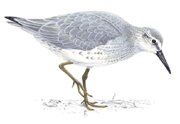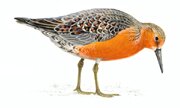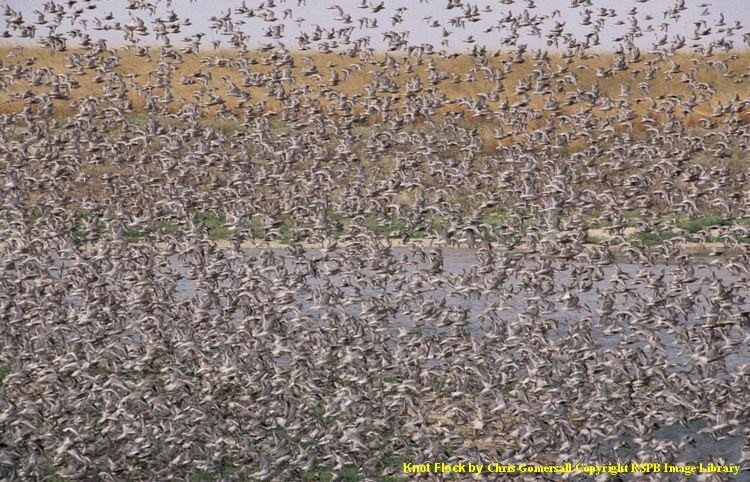Knot
Calidris canuta
AKA: Red knot (N America)
 Knot in Winter |
 Knot in Summer |
In terms of percentage of Eastern Atlantic population, Essex in the winter is one of the most important areas for the Knot. . Large numbers of birds visit Essex in winter from their Arctic breeding grounds and between August and May large flocks of these dainty little waders can be seen all along the Southend coast from Benfleet to Wakering with numbers peaking in December through to March. As the tide rises you can sometimes see huge flocks wheeling, twisting and turning and going from dark to white in the sun as they flash their pale underwings.
During winter the shores and mud flats of Essex hold over 45,000 of these birds which represents 13.1% of the entire Eastern population - an incredible number. Our inter-tidal mud flats are crucial for the winter survival of these birds as they search for their main food of small molluscs, crustaceans, and marine worms.
The knot is a dumpy, short-legged, stocky wading bird. In winter, It is grey above and white below but in summer plumage it transforms to a lovely brick-red colour. Many knots use UK estuaries as feeding grounds, both on migration and in winter, and therefore the population is vulnerable to any changes such as barrages, sea-level rises and human disturbance.
You can usually see the Knot all along our shore but look out for them especially on a rising tide as they probe for food with their bills - probing a few times and then running to a new spot just ahead of the waves.
Other huge concentrations appear at The Wash, Morecambe Bay, Thames, Humber and Dee estuaries, the Solway Firth and Strangford Lough.
|
||
 |
The Red Knot (as it is known in America) was once one of the most common of North American shorebirds, but they were slaughtered by the thousands during the 1800's and numbers have still not picked up on the Western Seaboard to their past historical levels.
Nesting:
Males perform aerial displays high over the moist tundra and glacial till that are their nesting grounds. The nest is on the ground, usually near water. It is a shallow scrape lined with leaves, lichen, and moss. Both parents incubate the 3 to 4 eggs for 21 to 22 days. The young leave the nest shortly after hatching and feed themselves. The female departs shortly after the young hatch, leaving the male to tend the young for 18 to 20 days, until they can fly.
Threats:
Threats to the population are the development of shorelines, limiting habitat, increased human disturbance, and oil spills along their migration routes and wintering range.
Knot Facts:
Eggs: 3-4
Incubation: 21-22 days
Fledging: 18-20 days
Maximum lifespan: 16 years
Length: 23-25cm
Wingspan: 57-61cm
Weight: 125-215g
UK wintering: estimated 298,000 birds
Our most important wintering bird is....?
The figures below are courtesy of Chris Tyas, Essex Area Manager of the RSPB which prove just how important our mud flats are to the Knot with regards to numbers and total of eastern population.
The figures for each species are derived from 5 years of WeBS data. With the qualifying levels for international importance taken from the annual WeBS Report. The Essex total for knot (45,715) represents 13.1% of the East Atlantic flyway population.
Top Ten Wintering Birds
Knot 45,715 - 13.1%
Brent Goose 35,716 - 11.9%
Grey Plover 17,120 - 11.4%
Bar-tailed Godwit 10,209 - 10.2%
Redshank 10,399 - 6.9%
Dunlin 81,404 - 5.8%
Black-tailed Godwit 2,835 - 4.1%
Ringed Plover 1,745 - 3.5%
Shelduck 9,788 - 3.3%
Teal 12,450 - 3.1%
A further nine species also winter in Internationally Important numbers in Essex: Turnstone, Pintail, Oystercatcher, Curlew, Lapwing, Shoveler, Cormorant, Golden plover & Wigeon.
This information is very important to us if we are lobbying against future disturbance for Wakering, Foulness and even Gunners Park.
Next time you are out and about you can watch the humble Knot in their twisting and turning formations and have some pride in the fact that our part of Essex is so important to them. Let's keep it that way.
Page last updated:
Web Design Graham Mee. © Copyright of all pages South East Essex RSPB Local Group. All images copyright of owners
The Royal Society for the Protection of Birds. Registered charity no 207076
Please read our privacy and visitor policy

